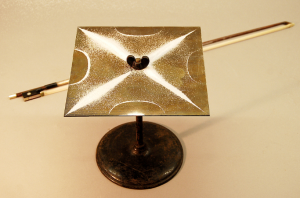We have created a miniature Chladni Device for our Museum, based on the historic one designed by Ernst Chladni (1756-1827), the German physicist and musician.
Chladni found that by drawing a violin bow along a metal or glass plate covered with sand, that various regular patterns would emerge. There is a fine replica of Chladni’s device at the Smithsonian Museum. Ours is 1:12 scale, and uses a teeny tiny violin bow.


The mathematical relationships of these fascinating patterns were taken up by the French mathematician Sophie Germain (1776-1831), shown below at age 14. Germain was not allowed to attend classes at l’École Polytechnique because she was a woman, but she was able to obtain the lecture notes in advanced mathematics by using the pseudonym Monsieur Antone-August Le Blanc. Her own mathematical discoveries, published under this name, gained the attention of other European mathematicians, most notably Carl Friedrich Gauss.
The patterns in sand emerge:
And are drawn and recorded: they begin to form categories:
These can then be calculated for their geometric relationships:
While our miniature Chladni Device is still being adjusted to try to make it actually work, we have taken great inspiration from Sophie Germain herself. Sadly, she died at age 55 from breast cancer. In her last years Germain was at work on a fascinating study of what she thought were the underlying metaphorical ideas that connect science, the humanities, and all of life.







Leave a comment